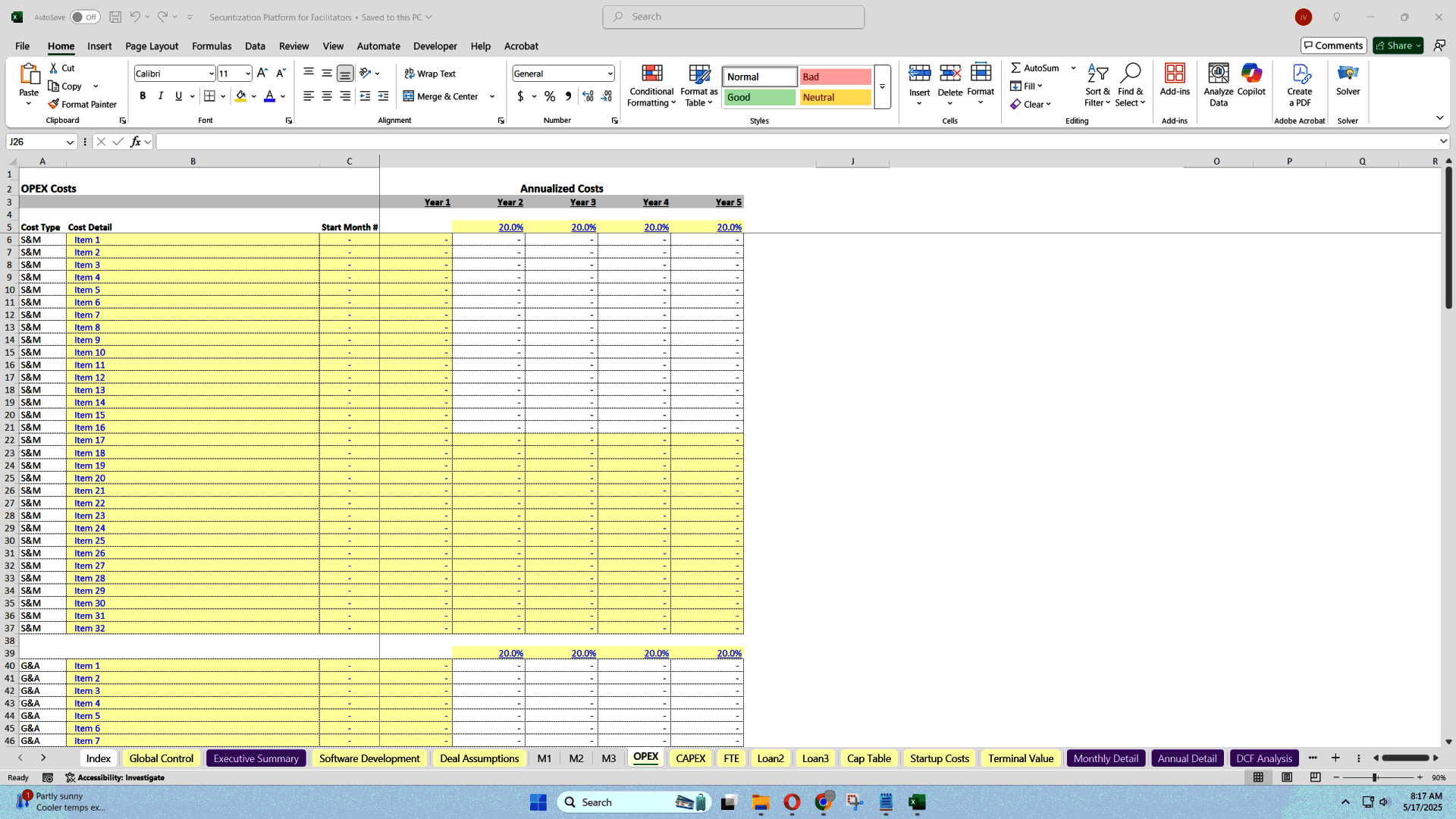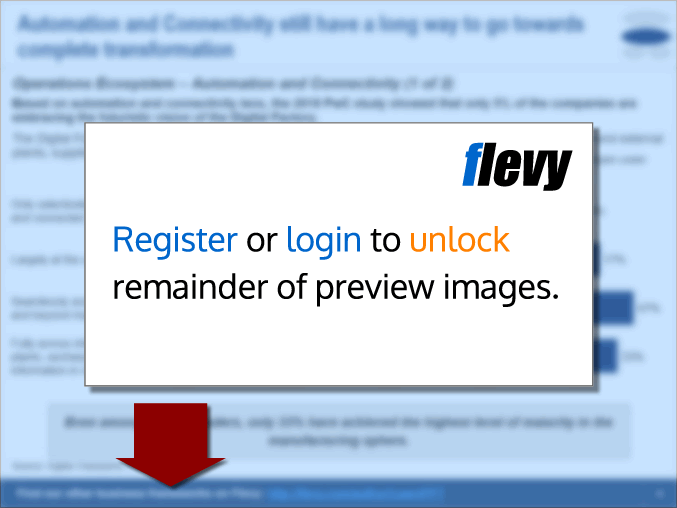Securitization Structurer Startup Financial Model (Excel XLSX)
Excel (XLSX)
VIDEO DEMO
INTEGRATED FINANCIAL MODEL EXCEL DESCRIPTION
What Does This Business Do?
Imagine you have two groups of people:
• Institutions (like banks or companies) that have loan portfolios—essentially, bundles of loans they want to sell or get off their books.
• Investors (like funds or large-scale buyers) who want to purchase these loans in order to earn a return over time.
Typically you'll also have some upfront costs to develop the platform / software that performs as much of the work as possible.
The business we're talking about helps connect these two groups. It matches the institutions that want to sell the loans with the investors who want to buy them. This matchmaker or "aggregator" doesn't actually own the loans long-term (unless they choose to, more on that below); rather, it makes the process easy for both sides and charges fees for doing so.
How Do They Make Money?
• Upfront Fees: When a deal finally closes (meaning the loans are successfully sold from one party to another), the aggregator charges a fee.
• This is usually a percentage of the total value—or "notional amount"—of the loan portfolio being sold.
• Ongoing Fees: The aggregator might keep managing the deal on behalf of the investor—think administrative tasks, reporting, or coordinating
with various parties. They'll often charge a percentage of the remaining loan balance every month or year for these management or service
duties.
• Buying and Reselling (Optional): Sometimes, the aggregator decides to briefly buy the loans themselves and then resell them to investors at a
slight markup. That means the aggregator could make an extra profit if they purchase the loan portfolios at a discount and then sell them at a
higher price. However, this comes with more risk because the aggregator needs to use some of its own money (or borrowed money) to buy
the loans first.
What's the Catch?
• Deals Take Time: It can be several months before a deal closes. But even while waiting for a deal to go through, the aggregator might need to
pay lawyers, consultants, rating agencies, or other service providers upfront. This timing gap is why "working capital" (cash on hand to run the
business) is so important.
• Risk of Holding Loans: If the aggregator decides to buy loans before selling them, it has to cover interest costs (if they borrowed money) and
might be stuck with the loans longer than expected. If the market changes, they could even lose money. But if they never buy the loans and
just collect fees, they have less risk but also less potential profit.
Why Use a Financial Model?
• Planning and Forecasting: The model (think of it as a big spreadsheet with formulas) helps the aggregator plan how much money they'll earn
and spend over time. It estimates revenue from fees, costs for salaries, legal fees, marketing, etc., and even projects how cash flow will look
month to month or year to year.
• Investor Insights: If the aggregator has outside investors, they'll want to see what kind of returns they can expect. The model calculates things
like profit margins, exit values, and how much cash the business needs to get started.
• Scenario Analysis: The aggregator can change assumptions—like how many deals it will close per year, how big the deals are, or how quickly
investors pay fees—to see how each scenario affects the bottom line. It's like asking, "What happens if each deal is 10% bigger?" or "What if it
takes twice as long to close deals?" and instantly seeing the answer.
Step-by-Step Example (Simplified)
• Deal Sourcing: The aggregator finds a bank that wants to sell a pool of loans worth $10 million.
• Investor Placement: The aggregator finds an investment fund that's willing to buy those loans.
• Upfront Fee: Once the deal closes, the aggregator collects a small fee—say, 1% ($100,000)—from the deal.
• Ongoing Management: Each month, the aggregator might also earn a small management fee (like 0.2% of the total portfolio per year). As the
loan gets paid down over time, the aggregator's monthly fee might decrease—but it continues as long as the aggregator manages the
portfolio.
• Optional Buy-and-Flip: Sometimes, the aggregator might actually buy that $10 million loan pool from the bank for $9.5 million and then sell it
to the investor for $10 million. That's a $500,000 profit—but they had to spend $9.5 million upfront (possibly borrowed). This adds complexity
and risk but can increase total profit.
• Expenses: All the while, the aggregator has expenses: staff salaries, lawyer fees, accounting costs, marketing, rent, etc. They need to ensure
they have enough cash flow to cover these before deals close.
Key Insights
• You Don't Make Money Until the Deal Closes: Cash flow can be tight if you rely on fees that only come in months or even years down the line.
• Working Capital is Critical: Because of the time it takes to close deals, having enough cash on hand to pay ongoing expenses is crucial.
• Scaling Staff and Overheads: As more deals happen, the aggregator may need more employees (underwriters, lawyers, salespeople, etc.).
• Costs will rise in line with deal flow.
• Risk vs. Reward: The optional "buying and reselling" piece can boost revenue but also substantially raises the stakes—more capital is needed
upfront, and any delay or drop in the market could hurt profits.
Why It Matters
• Real-World Application: This aggregator model is a prime example of how finance professionals bring together buyers and sellers who
wouldn't otherwise connect so easily.
• Entrepreneurial Opportunities: If you're studying business or finance, understanding how fee-based or facilitation businesses work can spark
ideas for your own ventures.
• Risk Management: This business teaches why forecasting and financial planning are essential—especially when payments are delayed or
uncertain.
• Collaborative Roles: Such a business involves lawyers, accountants, analysts, and salespeople working together, demonstrating how different
skill sets come together in modern finance.
Final Takeaway
This aggregator/facilitator model is about helping institutions sell loan portfolios to investors, collecting fees without permanently holding the loans. However, there's an option to take on more risk and potentially higher rewards by temporarily owning these loan portfolios. A careful financial model helps the aggregator anticipate cash needs, forecast revenues, manage operating costs, and decide how much capital to raise and invest.
In simpler terms, it's about connecting people who have something to sell (loans) with people who want to buy (investors), and charging fees to make it all happen smoothly.
Got a question about the product? Email us at support@flevy.com or ask the author directly by using the "Ask the Author a Question" form. If you cannot view the preview above this document description, go here to view the large preview instead.
Source: Best Practices in Integrated Financial Model Excel: Securitization Structurer Startup Financial Model Excel (XLSX) Spreadsheet, Jason Varner | SmartHelping
This document is available as part of the following discounted bundle(s):
Save %!
Industry-specific Financial Models (40+)
This bundle contains 67 total documents. See all the documents to the right.









